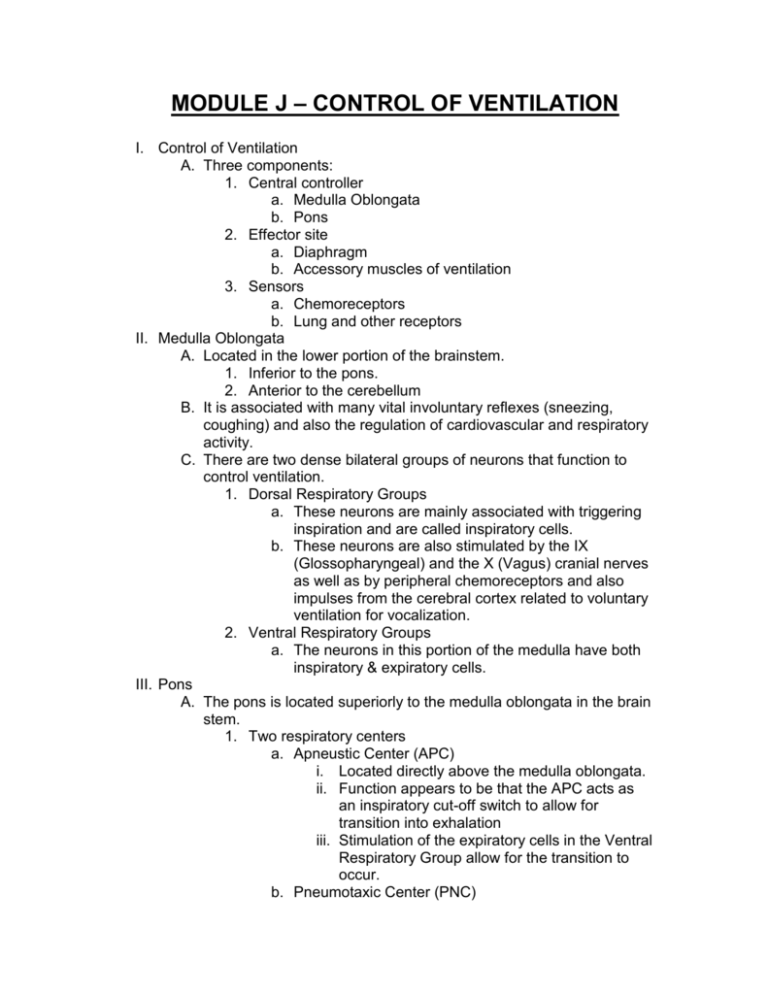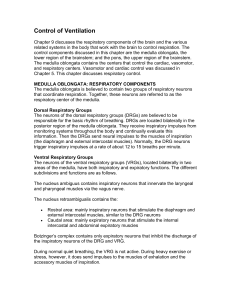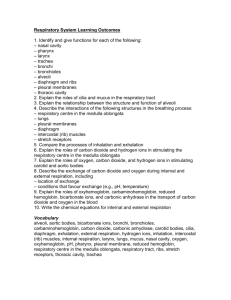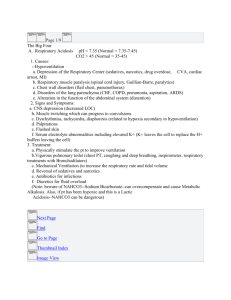module j – control of ventilation - Macomb
advertisement

MODULE J – CONTROL OF VENTILATION I. Control of Ventilation A. Three components: 1. Central controller a. Medulla Oblongata b. Pons 2. Effector site a. Diaphragm b. Accessory muscles of ventilation 3. Sensors a. Chemoreceptors b. Lung and other receptors II. Medulla Oblongata A. Located in the lower portion of the brainstem. 1. Inferior to the pons. 2. Anterior to the cerebellum B. It is associated with many vital involuntary reflexes (sneezing, coughing) and also the regulation of cardiovascular and respiratory activity. C. There are two dense bilateral groups of neurons that function to control ventilation. 1. Dorsal Respiratory Groups a. These neurons are mainly associated with triggering inspiration and are called inspiratory cells. b. These neurons are also stimulated by the IX (Glossopharyngeal) and the X (Vagus) cranial nerves as well as by peripheral chemoreceptors and also impulses from the cerebral cortex related to voluntary ventilation for vocalization. 2. Ventral Respiratory Groups a. The neurons in this portion of the medulla have both inspiratory & expiratory cells. III. Pons A. The pons is located superiorly to the medulla oblongata in the brain stem. 1. Two respiratory centers a. Apneustic Center (APC) i. Located directly above the medulla oblongata. ii. Function appears to be that the APC acts as an inspiratory cut-off switch to allow for transition into exhalation iii. Stimulation of the expiratory cells in the Ventral Respiratory Group allow for the transition to occur. b. Pneumotaxic Center (PNC) i. Located superior to APC. ii. Controls Apneustic center and “fine-tunes” breathing by sending inhibitory impulses to medulla. IV. Depression of Medulla Oblongata A. The function of the medulla oblongata is necessary for regulation of blood pressure, heart rate, and ventilation (i.e. life). B. When increased intracranial pressure is present as a result of cerebral trauma and edema or other intracerebral abnormality (tumor), the ability of the brain to move to accommodate swelling is reduced (the skull is fixed spot with only one outlet – the foramen magnum). As swelling continues, the medulla oblongata is compressed as it passes through the foramen magnum and blood flow to this area reduces. Eventually, this leads to brain death. C. Acute poliomyelitis. D. Certain drugs that depress CNS function. A classic example is Morphine Sulfate. V. Central Chemoreceptors A. Control of ventilation is accomplished by stimulation of the floor of the medulla of the brain, which is sensitive to H+ within the cerebral spinal fluid (CSF). B. During hypoventilation, CO2 molecules readily diffuse across the blood brain barrier and enter the CSF. The blood brain barrier is impermeable to H+ ions but very permeable to CO2. C. In the CSF: CO2 H 2O H 2CO3 H HCO3 D. The H+ ions cause the pH to decrease in the CSF 1. This increases ventilation (f increases) VI. Peripheral Chemoreceptors A. Control of ventilation is also controlled by chemoreceptors strategically located to alert the body to changes in blood chemistries that could lead to cardiopulmonary collapse. B. These chemoreceptors are located proximal to the baroreceptors responsible for control of blood pressure. C. Carotid Bodies 1. Located at the bifurcation of the internal & external carotid arteries. 2. When stimulated, afferent impulses travel by way of glossopharyngeal nerve (IX) to the medulla oblongata, to stimulate ventilation. D. Aortic Bodies 1. Located in the aortic arch. 2. When stimulated, afferent impulses travel by way of the vagus nerve (X) to the medulla oblongata, to stimulate ventilation. E. Both chemoreceptors respond to reduced levels of PaO2, increased levels of PaCO2, and decreased levels of pH (increased H+ ions). VII. F. When PaO2 falls to 60 mm Hg or less, the peripheral chemoreceptor is stimulated and a response is sent to the medulla oblongata to increase ventilation by increasing either the respiratory rate or the depth of ventilation. 1. This response is blunted when PaO2 falls below 30 mm Hg. G. The response is to PaO2; NOT CaO2. This means that these chemoreceptors do not respond to anemia or situations where the SaO2 is reduced without concomitant hypoxemia (CO poisoning). Pulmonary Reflexes A. Hering Breuer Reflex 1. This reflex is activated when receptors located in the walls of the bronchi and bronchioles sense that they are overstretched. 2. When stretched (as might occur during a deep inspiration) a reflex response is triggered to reduce the tidal volume. 3. They are only activated at large tidal volumes (greater than 800 – 1,000 mL) 4. They do not function during normal, quiet breathing B. Deflation Reflex 1. When the lungs are compressed or deflated (as may occur with atelectasis or a pneumothorax), the reflex stimulates the medullary centers to increase firing, resulting in tachypnea. 2. It is unknown why this reflex functions in this way. C. Irritant Reflex 1. Irritant receptors are located in the nasal mucosa, trachea, bronchi and bronchioles. 2. They create a vagal response when stimulated. 3. They are sub-epithelial mechanoreceptors that function under various conditions: a. They respond to mechanical stimuli that irritate the local tissues of the nasal mucosa and tracheobronchial tree. i. ET tubes ii. Suctioning iii. Bronchoscopy b. They respond to chemical stimuli that would irritate nasal mucosa and tracheobronchial tissue if inhalation would be allowed to continue. i. Noxious gases c. They respond to physiologic stimuli caused by chemical agents i. Example: Histamine induced bronchospasm 4. The effect includes: a. Increase in respiratory rate b. Cough c. Sneeze d. Laryngospasm e. Bronchoconstriction f. Gag reflex. D. Juxtapulmonary Capillary Receptors – J-Receptors 1. The “J” stands for “just next to” 2. J-receptors are located in the interstitial space between the pulmonary capillaries and the alveoli. 3. They respond to increased pulmonary capillary pressure that occurs with the following: a. Pulmonary capillary congestion b. Capillary hypertension c. Edema of the alveolar walls d. Emboli in the circulation 4. When stimulated, a reflex response triggers a rapid, shallow breathing E. Head’s Paradoxical Reflex 1. Paradoxically stimulates a deeper breath rather than inhibiting further inspiration. 2. Responsible for: a. Deep Breath (Sighs) b. First breaths of Infants







